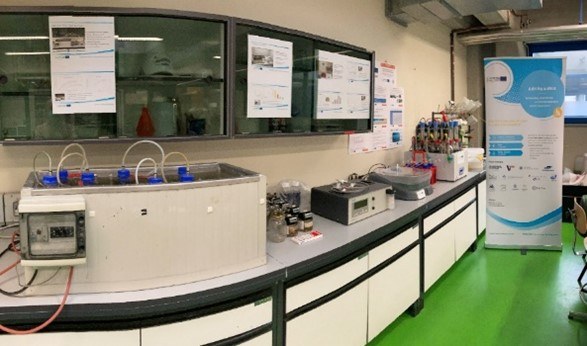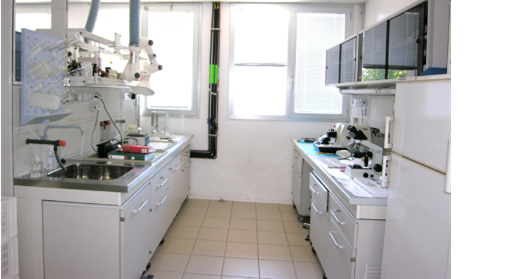Laboratories of the Animal and Veterinary Sciences Section
“bio3” laboratory biomass - biogas – biomethane
|
|
Livestock and Environmental Engineering Group (1) Bio Reactor Simulator system (BRS) - Laboratory system for anaerobic process simulation and methanogenic potential determination tests The facilities for evaluating the anaerobic digestion process, determining process yields and determining the methanogenic potential of organic matrices are located in the "Biomass" laboratory on the second floor of Rizzi - Block B. The BRS (Bio Reactor Simulator, Bioprocesscontrol, Sweden) is an instrument specifically designed for the study of continuous anaerobic digestion processes, both for scientific research and practical process optimisation. Among the many tests that can be carried out with the BRS are the simulation of transient states in anaerobic processes (e.g. cold start-up of the biogas plant), the influence of OLR on digester efficiency, and the simulation of multi-stage processes. |
|
|
(2) Container-mounted mobile pilot plant for anaerobic digestion trials aimed at scale-up (operating in a protected environment or transferable on-site) The anaerobic digestion pilot plant is now located outdoors at the Azienda Agraria dell'Università di Udine - Sede di Pagnacco. Scientific instrumentation at the service of anaerobic digestion plants Contact: Francesco da Borso, Alessandro Chiumenti |
Laboratory of endocrinology
|
Veterinary physiology and physiopathology of reproduction Laboratory dedicated to the reception/preparation/preservation of biological samples and the assay of hormones, metabolites and related molecules (e.g. NEFA, BHB) by means of biochemical tests and/or using RIA, EIA and AlphaLISA immuno-competitive systems for the assessment of the activity of the hypothalamic-pituitary-adrenal, gonadotropic, somatotropic axes applied to different biological matrices of traditional and alternative (non-invasive) types. Referente: Alberto Prandi, Tanja Peric |
Bromatological Analysis Laboratory
|
|
Animal nutrition and feeding In the bromatological analysis laboratory, chemical analyzes are carried out on feeds (fodder, concentrated, by-products) and biological samples taken from animals (feces, urine, samples of ruminal and intestinal materials). The laboratory is equipped with all the equipment for the preparation of the samples (various types of mills and drying ovens) and the equipment for the determination of the crude chemical composition (analytical balances, Kieldahl N analyzer, Soxhlet fat extractor, 550 °C, Ankom equipment for the determination of fibrous fractions), sieves for particle size evaluation, NIRS equipment and centrifuges for the treatment of liquid samples. Contact: Mauro Spanghero, Alberto Romanzin, Chiara Sarnataro |
Laboratory of Animal Nutrition and Feeding
|
|
Animal Nutrition and Feeding The experimental activities carried out in the nutrition laboratory are mainly simulation tests of the digestion processes that occur in animals. Exclusively in vitro technologies are used, without the direct use of experimental animals ("cruelty free" tests), with lower times and costs than experiments using live animals. Contact: Mauro Spanghero, Alberto Romanzin, Chiara Sarnataro |
Histology laboratory
|
|
Parasitology laboratory The laboratory prepares preparations, after fixation and processing, of animal and plant tissue samples, pathological or normal, for histological evaluation in the context of histopathological research or diagnostic activities for third parties. Specific histochemical and immunohistochemical methods for diagnostics and/or etiopathogenetic studies are currently used in the laboratory, such as the preparation of cytological preparations Contact: Marco Galeotti, Paola Beraldo |
Parasitology laboratory
|
|
Veterinary pathology and parasitology The lab routine involves the preparation and reading of qualitative-quantitative copromiscroscopic preparations and fresh parasitological screening for diagnostic purposes for research activities. In the context of ecoparasitological studies, the identification of animal parasites, on a morphological or biomolecular basis (carried out in another lab), is implemented using the Total Worm Count technique. Contact: Marco Galeotti, Paola Beraldo |
Microscopy room
|
|
Veterinary pathology and parasitology
Contact: Marco Galeotti, Paola Beraldo |
Necropsy room
|
Veterinary pathology and parasitology Room equipped for autopsy examinations of wild and domestic animals. Contact: Marco Galeotti, Paola Beraldo |
Fish enclosures
|
|
Veterinary pathology and parasitology The Veterinary Pathology group is equipped with a recirculating housing unit for freshwater and saltwater fish species, located at the Pagnacco farm and a User Plant, recognized by the Ministry of Health. Contact: Marco Galeotti, Paola Beraldo |













